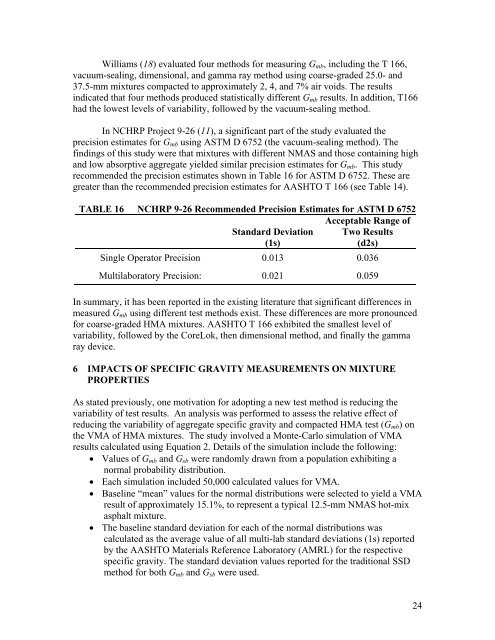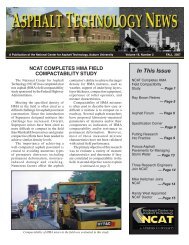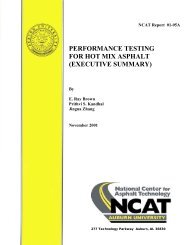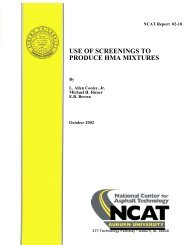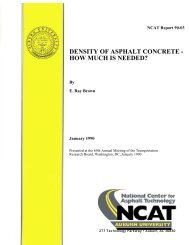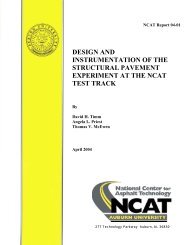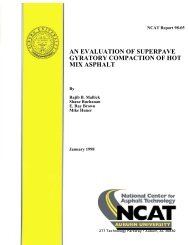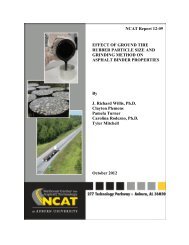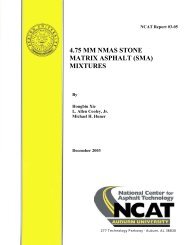A Review of Aggregate and Asphalt Mixture Specific Gravity ...
A Review of Aggregate and Asphalt Mixture Specific Gravity ...
A Review of Aggregate and Asphalt Mixture Specific Gravity ...
Create successful ePaper yourself
Turn your PDF publications into a flip-book with our unique Google optimized e-Paper software.
Williams (18) evaluated four methods for measuring G mb , including the T 166,vacuum-sealing, dimensional, <strong>and</strong> gamma ray method using coarse-graded 25.0- <strong>and</strong>37.5-mm mixtures compacted to approximately 2, 4, <strong>and</strong> 7% air voids. The resultsindicated that four methods produced statistically different G mb results. In addition, T166had the lowest levels <strong>of</strong> variability, followed by the vacuum-sealing method.In NCHRP Project 9-26 (11), a significant part <strong>of</strong> the study evaluated theprecision estimates for G mb using ASTM D 6752 (the vacuum-sealing method). Thefindings <strong>of</strong> this study were that mixtures with different NMAS <strong>and</strong> those containing high<strong>and</strong> low absorptive aggregate yielded similar precision estimates for G mb . This studyrecommended the precision estimates shown in Table 16 for ASTM D 6752. These aregreater than the recommended precision estimates for AASHTO T 166 (see Table 14).TABLE 16 NCHRP 9-26 Recommended Precision Estimates for ASTM D 6752Acceptable Range <strong>of</strong>St<strong>and</strong>ard Deviation(1s)Two Results(d2s)Single Operator Precision 0.013 0.036Multilaboratory Precision: 0.021 0.059In summary, it has been reported in the existing literature that significant differences inmeasured G mb using different test methods exist. These differences are more pronouncedfor coarse-graded HMA mixtures. AASHTO T 166 exhibited the smallest level <strong>of</strong>variability, followed by the CoreLok, then dimensional method, <strong>and</strong> finally the gammaray device.6 IMPACTS OF SPECIFIC GRAVITY MEASUREMENTS ON MIXTUREPROPERTIESAs stated previously, one motivation for adopting a new test method is reducing thevariability <strong>of</strong> test results. An analysis was performed to assess the relative effect <strong>of</strong>reducing the variability <strong>of</strong> aggregate specific gravity <strong>and</strong> compacted HMA test (G mb ) onthe VMA <strong>of</strong> HMA mixtures. The study involved a Monte-Carlo simulation <strong>of</strong> VMAresults calculated using Equation 2. Details <strong>of</strong> the simulation include the following: Values <strong>of</strong> G mb <strong>and</strong> G sb were r<strong>and</strong>omly drawn from a population exhibiting anormal probability distribution. Each simulation included 50,000 calculated values for VMA. Baseline “mean” values for the normal distributions were selected to yield a VMAresult <strong>of</strong> approximately 15.1%, to represent a typical 12.5-mm NMAS hot-mixasphalt mixture. The baseline st<strong>and</strong>ard deviation for each <strong>of</strong> the normal distributions wascalculated as the average value <strong>of</strong> all multi-lab st<strong>and</strong>ard deviations (1s) reportedby the AASHTO Materials Reference Laboratory (AMRL) for the respectivespecific gravity. The st<strong>and</strong>ard deviation values reported for the traditional SSDmethod for both G mb <strong>and</strong> G sb were used.24


